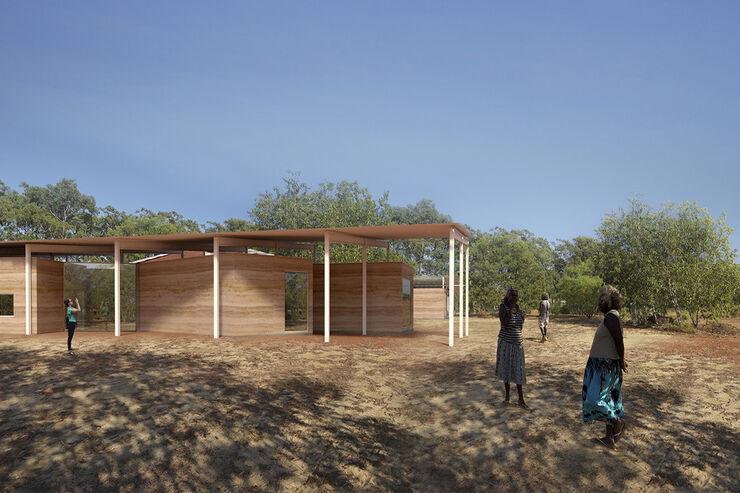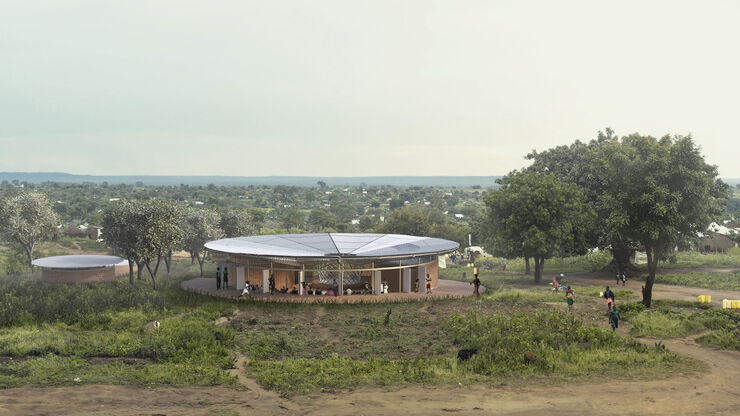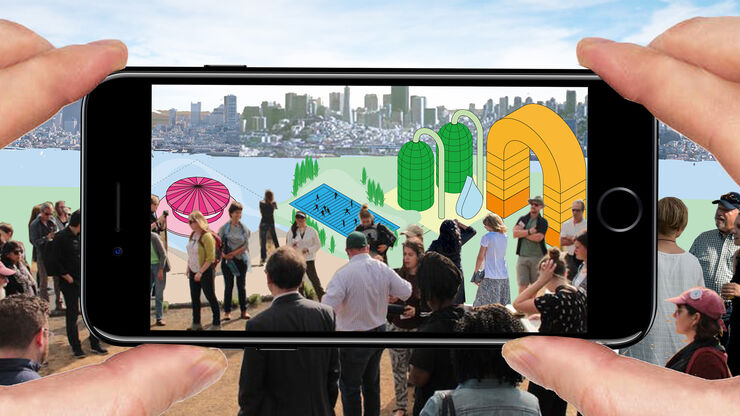Transcript
Mark Loughnan introduces episode:
There is inherent value in doing good, and there are lots of ways of course, to contribute to society and to do good, or to add value. I think design is a skill that is undervalued in how it can add and contribute to the way people live their lives. Whether that be in a city, in a modern city, or in parts of the world who aren’t so fortunate, perhaps the other 90% notionally who have no access to design services. So how can we, as a design profession, improve the way people live in a wider spectrum and how can big business contribute to that notion?
I’m Mark Loughnan. And I am a principal at Hassell. You’re about to hear a part of a panel conversation we hosted in support of Humanitarian Architecture Week. We hosted it in our Melbourne studio. One of our panellists was Brian Bell. He is considered one of the champions of public interest design. He’s the founder and director of Design Corp and a founder of the Public Interest Design Institute. Joining Brian is Dr. Esther Charlseworth and Esther’s a professor in the School of Architecture and Urban Design at RMIT university and is the director of the Humanitarian Architecture Research lab. Esther is also the founding director of Architects Without Frontiers and the academic director of the brilliantly named Master of Disaster Design and Development degree at RMIT. The biggest challenge we might face when it comes to proposing design led solutions to public issues is demonstrating the value we can bring to the project.
Bryan Bell shared with the group, one of the most compelling examples of value being shown in post genocide Rwanda.
Bryan Bell begins speaking:
There was a lecture at the school of public health by a gentleman named Paul Farmer. Paul Farmer was talking about converting military bases in Rwanda to hospitals. And this was just after the genocide and the military had been implicated in that as well. So the idea of converting military bases to hospitals was an amazing healing, literally, for the country. There was a graduate student named Michael Murphy. So Michael went up to Paul Farmer after the lecture and said, “I’d like to work for your architect.” Anybody want to guess what Paul Farmer said? He was building hospitals all over the world. He said, “I drew the last hospital on a napkin. Why do I need an architect?”
A month later, Michael got a call from Paul Farmer, who said, “I’m building a hospital for 400,000 people in region named Butaro. Are you interested?” Well, I don’t know how many of you have designed a hospital. Michael had not, but he only had to do better than a doctor’s napkin sketch. Michael went down to Rwanda. He looked at the hospitals Paul Farmer was building. He realised people were coming to those hospitals with communicable diseases and spreading them in the hallways and in the waiting rooms. And so he showed Paul Farmer that his lack of design was leading directly to a negative impact on his mission. So Michael did this first hospital for free, but Michael did more than that. It wasn’t just about health. Do you know what Paul Farmer did to build these hospitals previously? It was based purely on cost. He hired a Chinese corporations to come in and build the hospitals.
Well, that meant all the workers came from China. Nobody locally got a job. So Michael said, “We’re not doing that.” They hired a thousand local people, gave them food and health insurance during construction. And guess what? It turned out to be cheaper than the Chinese corporations. The benefit of, publicity of this, actually led to a direct positive impact in that more and more doctors wanted to go down here. So they ended up building housing for the doctors. It’s beautiful housing, it won an architecture record Housing of the Year award. But now it’s a model campus for a nationwide programme of health in Rwanda. Paul Farmer became the biggest design advocate you can imagine. These projects gain value when they do more than one thing.
Mark Loughnan speaks:
Sometimes perhaps it’s hard to see the impact that a project will have, or the outcome, it will have and the long term legacy that a project might have on people’s lives. Their inherent value is what comes after the building is finished. So how do you measure that? Are they healthier? Are they interacting more? Are there more jobs? Are they educating themselves? Are they training themselves? Is it resonating through the community? Is it connecting people? I think these are all things that really do have an impact on the bottom line. Doctor Esther Charlesworth.
Doctor Esther Charlesworth begins speaking.
Increasingly, if you can’t measure things in any profession and in design, if you can’t measure the social impact, you will be at a loss. Because that is ultimately how you will engage a broader group of people, of bureaucrats, who only talk in numbers. And I don’t think we’re very good at articulating or measuring. We’re definitely not trained to. If you can’t measure it in the development or disaster space. If you can’t scale up a solution from three houses to 10,000 shelters, then you’re wasting your time.
Bryan Bell speaks:
And you have to think about that in the beginning. Because a lot of measurements are before and after. And if you didn’t measure before and believe me, I’ve made some stupid mistakes. If you didn’t measure before, you can’t measure the change. So the fundamental questions that we ask is, what is the challenge? Who is the community impacted by that? Who are the stakeholders? What is the collective vision of success? And who are you going to ask to verify this? And then the final question is how are you going to measure that success? So this is where we increase our value. This is where we demonstrate to the public, what we can do for the issues that they care about.
Mark Loughnan speaks:
The opportunity here is immense. As designers, we are curious and passionate. Insight and creativity is key to the way we work. We’re interested in uplifting the way people live and the quality and experience of our lives. It’s a really urgent topic, given the climate change issues and environmental issues that we’re facing in the world today.
Doctor Esther Charlesworth speaks:
The Asia Pacific region is home to 80% of the world’s natural disasters. And yet the amount of trained professionals in the built environment sector that we have, probably on one hand in the Australasia region is about a hundred people. So to me, it’s not even a moral imperative anymore. It’s about the cost of business not being aware, of not being engaged. The cost of not expanding your practise in new and dynamic ways to meet the emerging challenges of our time. You will be left behind if as a global practise, you are not engaged or involved in these areas. You can be doing award winning projects, but my argument is always that the vulnerable are in most need of good design. How do we be intelligent and strategic about embracing a far more diverse community than most design practises deal with?
Bryan Bell speaks:
I firmly believe that every issue is a design issue in some way. I am guided by what’s on the front page of the paper. That’s where I find my issues. So the challenge is, how can this issue be positively impacted by design or planning? One of the great public designers, Sergio Palleroni, he just did a homeless veterans village in Portland. And it was so successful, partly because he got the construction industry involved, they’re now doing three more. One of my favourite quotes is by Sergio. He says “90% of the impact of my projects is outside of the bricks and mortar.” Community equity, social justice, things that his projects accomplish that are beyond the programming activities inside the building. That’s only 10% of the positive impact that his projects have. Think about that. In the Public and Design Practise guidebook, there is an index by issue. So I’d like to think that a city planner might say, “We have a crime problem in this neighbourhood. Let me look up what other design projects have done to reduce crime.” That’s when we’re going to start to be getting phone calls.
So one of the amazing things we bring to the table is the ability to rapidly visualise multiple solutions and communicate them. And I think that if you make it an inclusive participatory process, including the end users, I just believe and know that this is something we can do for the world that really nobody else is able to. So a design idea is an asset and assets are what is needed. And we can produce these, how many ideas can we come up with in a day, is a fricking superhero skill that we have. The conversation, the communication, the visioning, these are all things that we can do to make sure that in the end, success is achieved and it can be measured. And that becomes the proof to show to the public, look, we did this, we met this issue, here’s the evidence. And chalk it up to another issue addressed by design .
Mark Loughnan concludes:
All of our professional lives we need to think about how we can add value and meaning for the future. And in our case, as a global design practise, we’d really like to be able to use our services in a wider way and effectively, I think add value to other corporations through our design services that inherently loops back in and adds value to them as a practise, as a brand, as a talent attractor, and ultimately for the future. We know that there’s a corporate appetite where adding value to the way and improving people’s lives is inherently measurable and of value to the corporate world. We can provide design services and we need the corporate world to join the dots, effectively between the need and our services to the way people can improve the way they live. There’s really a whole world out there that can potentially benefit from what we do. I’m Mark Loughnan. Thanks for listening.





